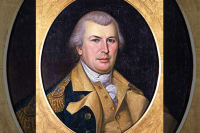Island music in the mountains: Western Carolina University’s gamelan orchestra helps share the music of Malaysian culture
By Michael Beadle
A few days before Halloween, strange sounds were coming from room 451 in the Coulter Building on the campus of Western Carolina University.
To the untrained ear, it was like a fantastic symphony of wind chimes and coconuts marching in an island celebration half a world away. But this orchestra of pot-shaped gongs, xylophone-like keyboards, hand drums and hanging gongs is, in fact, the low-tech ensemble known as gamelan, which uses mostly tuned metal percussion instruments to play music that comes from Bali, Java and the islands of Malaysia in Southeast Asia.
During a recent rehearsal for an upcoming concert, Western Carolina’s gamelan ensemble received some expert guidance from Han Kuo-huang, a Chinese-born gamelan master who helped inspire the formation of Western’s group when he visited Cullowhee back in 1996 as part of a lecture series on world music. Han, who retired from Northern Illinois University and is now a visiting professor from Kentucky, is no stranger to Western Carolina. He’s repeatedly visited Cullowhee to share what he knows of this exotic art form.
“He’s got a 30-year head start on us,” joked Will Peebles, who directs Western Carolina’s gamelan program and also serves as head of Western’s music department.
Even for veteran musicians like Peebles, entering the world of gamelan can be like learning a totally new language. Much of the gamelan tradition was passed along orally from one musician to the next, and only within the last century or so has it been written down and shared with Western culture, thanks in part to the Canadian-born musician and composer Colin McPhee, who helped popularize gamelan music in the 1930s.
Related Items
Han learned about gamelan music from one of McPhee’s students and has been sharing songs with Peebles, who has, in turn, recorded them on tape and written down the percussion beats using a matrix of numbers that correspond to a scale — four notes in the Balinese scale, for example. There are no bars or treble clefs, only a numerical notation that’s read left to right.
Han stresses the importance of memorizing the sounds and not simply relying on sheet music. The notes on a page can only take you so far. Peebles agrees, comparing it to Shakespeare’s “To Be or Not To Be” speech, which can be delivered a number of ways with many different shades of subtlety.
“For music, there are any number of right ways to play a piece — and a number of wrong ways,” he said. “Each player has to invent that for himself.”
As part of the rehearsal, Han led Peebles and the Western Carolina gamelan ensemble through a few Balinese songs, repeating the cyclical melodies again and again. After the musicians checked with each other and with Han about when they were supposed to come in for particular beats in the song, they agreed to start again from the top.
“Alright, let’s try it; let’s be brave,” Peebles said.
These traditional songs require acute attention to timing and pacing. When a song speeds up or slows down, musicians can be left scrambling with their mallets to keep up with the beats. Unlike a traditional Western song where the opening strong beats begin the harmonies to which the melody must conform, in gamelan music, the strong beat comes at the end, so the previous melody notes anticipate rather than harmonize the ending.
“And that’s probably one of the trickiest things to get your mind around,” Peebles explained.
By the end of the rehearsal, everyone seemed to be hitting the notes right on time.
“It’s getting better,” Han told his students. “You learned this in three hours. I learned this in two weeks.”
Gamelan music was traditionally played to accompany rituals and puppet plays based on Hindu epics such as the Ramayana. Western Carolina’s gamelan repertoire includes a wide variety of songs. Some feature nature-themed titles like “Ricik-Ricik” (Sound of the Creek) and “Manyar Sewu” (A Thousand Birds) while others like “Lancaran Singa Nebah” (Pouncing Lion) and “Ladrang Singromansah” (Preparation for Battle) carry a more ominous tone in their titles. In some cases, Peebles’ students might compose a piece for the ensemble.
Western Carolina is actually home to three gamelan orchestras — an iron gamelan degung, an iron Central Javanese slendro tuning gamelan, and a bronze gamelan angklung from the island of Bali. Each has its own name, tuning system and personality, according to Peebles. There are only a handful of gamelan ensembles in the Southeast and about 150 in the United States.
Just like the unique nature of gamelan music, so too is the story of how such a faraway culture came to Western Carolina’s campus. It all began in March of 1996 when Han, then a professor of ethnomusicology at Northern Illinois University, made his first visit to Western Carolina. Han was born in mainland China and grew up in Taiwan, but his family later came to the United States in 1964, and he began playing gamelan music in the 1970s. When he fist came to Cullowhee, he brought a Balinese-style gamelan angklung and Chinese instruments, and offered a lecture and music demonstrations for students and faculty.
A few years later, Peebles learned about a collection of gamelan instruments that was being sold on eBay, and he put in the winning bid. Over spring break in 1999, he and colleague Alan Mattingly flew to California to pick up the instruments. They rented a truck and drove the gamelan some 2,500 miles back to Western Carolina.
Later that spring, Han made a return visit to WCU and helped Peebles establish an ensemble of gamelan musicians. After more lectures and workshops with Han, the ensemble began putting together a repertoire to perform publicly. By the end of year, WCU’s gamelan ensemble was giving workshops in area schools and had its inaugural concert in Cullowhee on Dec. 1, 1999.
Since then, the gamelan ensemble has grown to include about a dozen or more students as well as some professors. Though students eventually graduate out of the program and move on, more are drawn each year to replace them. Over the years, the ensemble has performed on tour throughout North Carolina and eastern Tennessee, at university events and festivals, in area schools as outreach programs, and through music workshops and conferences. Peebles and his fellow gamelan musicians have traveled to West Coast workshops and hosted visiting gamelan experts for student and community workshops.
All kinds of students continue to be attracted to the gamelan ensemble.
“We get music majors; we get non-music majors,” Peebles said.
Some come looking for a different kind of music; others play for a semester and move on. One student, Peebles recalled, said he’d always wanted to play an instrument but was discouraged from trying when he was younger.
Gamelan has that kind of peculiarity to it that attracts people to music even if they might not otherwise be drawn to traditional music. As part of its educational outreach programs, Peebles allows audience members a chance to ask questions and play the various gamelan instruments after a concert.
“I think we need to encourage musical expression,” Peebles said.
Brittany Cardenas, a senior at WCU, discovered gamelan music as a freshman when one of her friends from marching band invited her to a gamelan rehearsal.
“I’d seen their recital the semester before and I thought it looked fun, so I was eager to see what it was about,” she explained.
Like many students who have discovered gamelan music, Cardenas found it quite different.
“Don’t expect anything going in except to hear music you’ve never heard before,” she said.
Now with a few years of gamelan experience under her belt, she still finds the non-Western style music both appealing and frustrating to learn and play. After all, gamelan music is typically not written out — it’s more like a folk tale or fable in the way that it’s passed down through the generations orally.
“If you’ve ever read music before and are used to the format of Western notation, you may find the lack of structure hard to grasp at first,” Cardenas said. “But once you get how it’s written, it’s not that hard.”
Zach Dearman, a junior at Western Carolina, has also been rehearsing and performing with the WCU gamelan orchestra since his freshman year. Like Cardenas, he’s toured with the ensemble and has taken a keen interest in sharing the cultural traditions of gamelan music.
“The only way to learn it is to do it,” he said.
Expect to see a WCU gamelan CD out soon. Peebles and the orchestra recently recorded songs for the CD and the release date could be as early as this winter. For more information about WCU’s gamelan program or its touring schedule, contact Will Peebles at 828.227.3258 or email This email address is being protected from spambots. You need JavaScript enabled to view it..









